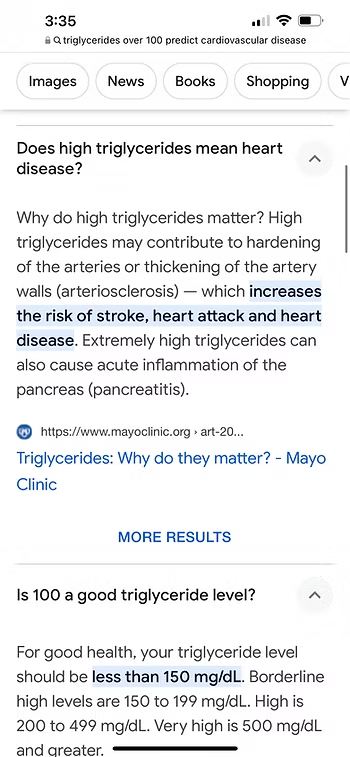Hey there, health-conscious friend! Ever wondered if that extra serving of pasta or that second piece of pie is causing more harm than good? There’s a sneaky number in your blood work that can give you the answer, and today, I’m pulling back the curtain to reveal it.
Now, don’t glaze over. We’re not about to dive deep into science class. Instead, think of triglycerides as little messengers in your blood. If they’re shouting too loudly, you might be having a few too many carb-filled treats.
Let me paint you a picture. Imagine a friend of mine, who’s just like you and me. He got his labs done, and the report showed something alarming.
Reading Between the Lines of the Lab Report
In his report, right there, bold and upfront, was the word “Triglycerides.” If you’re like most folks, you want that number between 0 and 149. Anything below 100? Gold star for you!
But my friend? His number was off the charts at a whopping 346. That’s like showing up to a quiet library with a brass band!
Here’s the simple truth. When you eat more carbs than you should, they turn into sugars in your blood. Now, sugar isn’t just bad for your teeth—it’s not great for your insides either. It’s kind of like an unwelcome houseguest: your body needs to do something with it fast.
The Sugary Problem and Its Solution
Here’s where it gets interesting. Your body’s way of dealing with this sugar invasion? Your liver steps up, acting like a superhero, and transforms this sugar into triglycerides. Sounds cool, right? But there’s a twist. This transformation isn’t like a magic show – it needs a LOT of energy. Imagine running a marathon after eating a big meal. You’d feel worn out, right? That’s how your liver feels, and it can leave you feeling tired too.
If your triglycerides are soaring over 100, maybe it’s time to rethink that extra serving of fries or that sweet drink. Aim to keep your levels between 80 to 100. It’s a small change, but your liver will thank you. Avoiding high triglycerides means having a healthy lifestyle, and there are other parts of your glycemic index that matter too.
Share the Knowledge
Did this tidbit open your eyes? I bet it did! If you found this helpful, don’t keep it a secret. Pass it on! Share it with someone you care about. And hey, while you’re at it, drop a comment. We love hearing from our smart readers like you.
Frequently Asked Questions (FAQ)
Triglycerides are a type of fat in your blood. When levels are too high, it often signals that you’re eating more carbs than your body can handle, which increases your risk for cardiovascular disease.
Ideally, triglycerides should be below 100 mg/dL, with the standard range considered 0–149 mg/dL. Keeping your levels in the 80–100 range is a good goal for long-term health.
When you eat more carbs than your body needs, they turn into sugar in the blood. Your liver then converts this sugar into triglycerides, which can raise your levels and leave you feeling tired.
Reducing carb intake, avoiding sugary drinks, and focusing on a balanced diet with protein and healthy fats can help lower triglycerides. Lifestyle changes like regular exercise also make a big difference.








